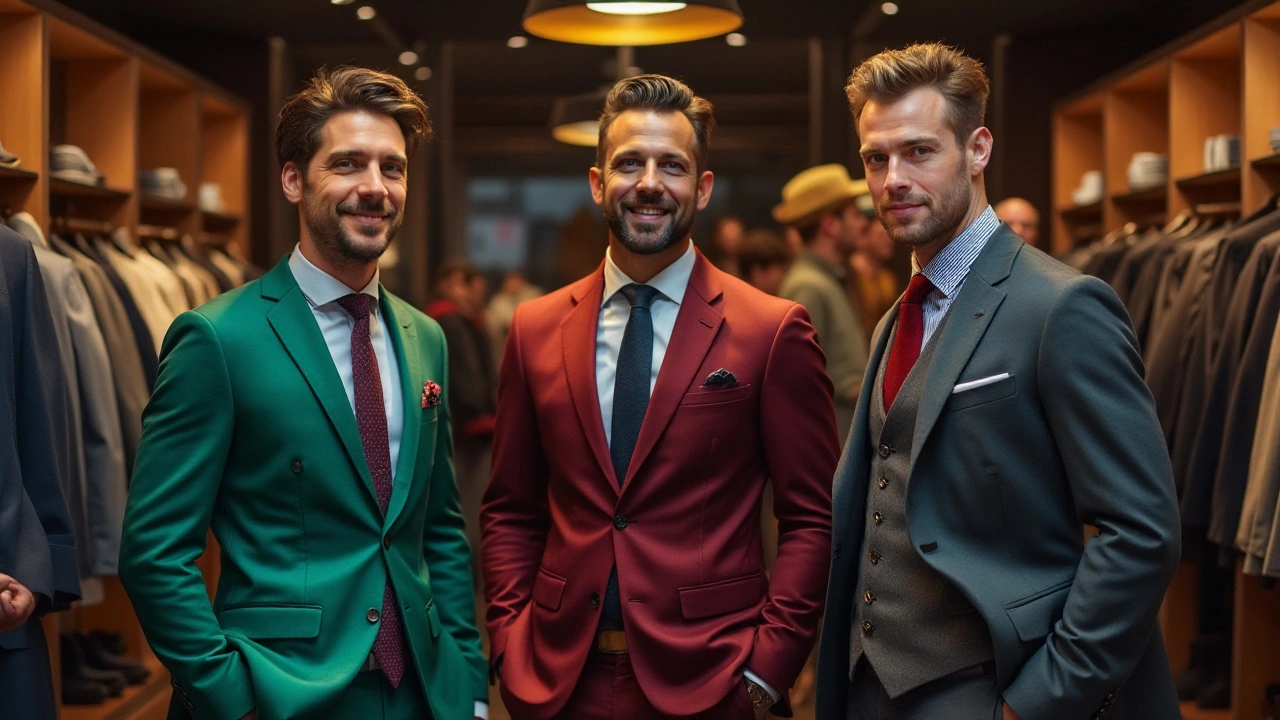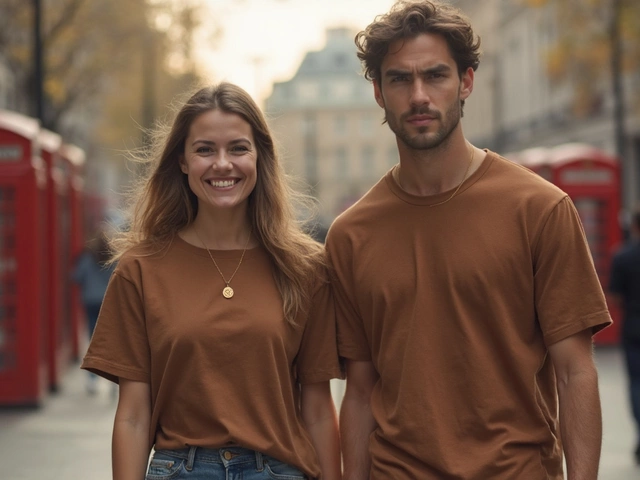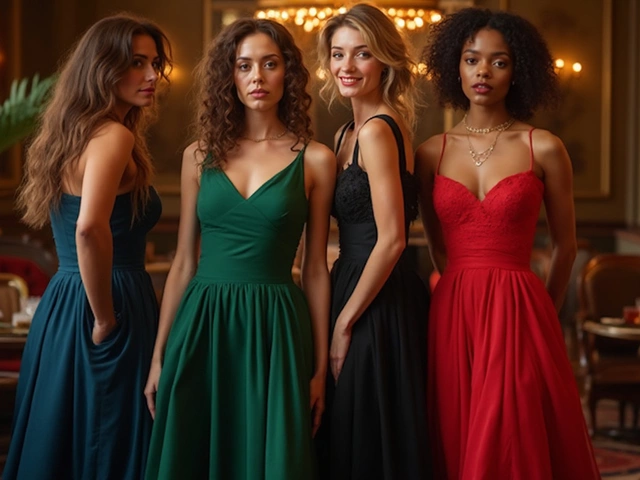Choosing the Perfect Suit Color for Every Man

- Cleo Fairchild
- 19 January 2025
- 0 Comments
In the world of men’s fashion, selecting the perfect suit color can make a grand statement about one’s persona and style. Men’s suits are not just about fit and cut; color plays an equally pivotal role. Whether stepping into an interview, attending a wedding, or merely wanting to feel unstoppable at work, the right hue can amplify confidence and enhance your look.
Gone are the days of being restricted to monochrome palettes. Today, the choices are abundant, each color offering a distinct vibe and message. It's essential to consider aspects like personal taste, the occasion at hand, and even your skin tone when making a decision. Through this article, explore the endless possibilities and unlock the secrets to choosing a suit color that truly resonates with who you are and the impression you desire to leave.
- Understanding Basic Suit Colors
- Choosing a Suit Color for the Occasion
- Considering Skin Tone and Personal Style
- Trends and Timeless Colors
- Care and Maintenance of Different Colored Suits
Understanding Basic Suit Colors
When delving into the world of men's suits, a good starting point is familiarizing oneself with the basic colors that lay the foundation of any sophisticated wardrobe. The classic trio of suit colors—black, navy, and gray—remains unrivaled in their versatility and timeless appeal. Black suits often embody a sense of elegance and power, making them a staple for formal events like weddings and funerals. This color's straight and solemn vibe makes it less ideal for day-to-day office wear, especially in informal settings.
Navy is often heralded as the most flexible suit color, favored for its professional yet approachable appearance. It easily complements a range of skin tones and can be paired with almost any color of shirt or accessory. Navy suits tell a story of confidence without the rigidity of a black ensemble, making them ideal for a variety of occasions, from job interviews to cocktail parties. Many style advisors, including acclaimed designer Tom Ford, advocate for the navy suit, noting that,
“The right navy suit can transition from work meetings to formal dinners with ease, just by changing a tie or adding a pocket square.”
The gray suit, particularly in shades of charcoal, offers a middle ground with its neutral tone. It balances the formality of black and the friendliness of navy, creating opportunities across professional and semi-formal settings. Gray, especially lighter shades, can highlight personal style more distinctively, as it lends itself well to creative combinations with colorful shirts or ties. Opt for a variety of grays in your wardrobe; darker grays exude authority, while lighter hues add a contemporary touch. Thus, understanding these basic suit colors is essential for anyone looking to build a cohesive and versatile wardrobe.
Choosing a Suit Color for the Occasion
When it comes to selecting a suit color, the occasion dictates much of the choice. The traditional black suit has long been a go-to for formal events such as black-tie galas, funerals, and evening parties. Its classic nature ensures that it communicates sophistication and respect for tradition. However, for modern-day weddings and formal business meetings, many are leaning towards deep navies and charcoals. These hues are seen as less harsh than black, offering elegance while allowing more personality to shine through.
Navy suits, in particular, are celebrated for their versatility, making them suitable for both corporate settings and social gatherings. They pair well with a multitude of shirt and tie combinations, effortlessly transitioning from a work meeting to post-office drinks. Light grey suits, on the other hand, shine in the spring and summer months, when their lighter hue complements the warmer, brighter days. Such suits are ideal for daytime weddings or garden parties, where a darker suit might feel out of place and overly formal.
For those looking to leave a memorable impression at a less formal event, colors like burgundy or olive have emerged as fashionable choices. These shades offer a refreshing departure from the norm and can create striking looks when matched with the right accessories. The choice between these vibrant colors can symbolize boldness and creativity, perfect for cocktail parties or art gallery openings.
"The color of a man's suit is not merely fabric; it reflects his aspirations and speaks volumes before he even utters a word," remarked renowned fashion icon Tom Ford in an interview with GQ magazine.
While events guide color selection, geographical location and cultural norms may also play a role. In tropical regions, tan or beige suits are popular due to their heat-friendly nature, whereas, in urban environments, a sharp black or dark grey might resonate better with the local aesthetic. As one delves into the myriad of options, it's evident that the right suit color can weave together the narrative of the event, personal taste, and environmental considerations, crafting an impeccable and lasting impression.

Considering Skin Tone and Personal Style
Choosing the right suit color involves more nuance than simply following trends. An important factor often overlooked is matching suit colors with your skin tone. Men’s suits come in a wide range of shades, and when selected thoughtfully, they can not only enhance your natural features but also accentuate your personal style. To make an informed choice, it’s beneficial to understand which colors work harmoniously with different skin tones. Typically, skin tones are categorized into three primary spectrums: light, medium, and dark. Understanding these categories helps in making a deliberate choice that flatters and complements your complexion.
For those with lighter skin tones, colors that offer a contrast are generally more flattering. Darker shades, like navy and charcoal, create a balanced look that can make light skin appear more vibrant. Men's suits in these colors are classic choices that are incredibly versatile for various occasions. Medium skin tones, on the other hand, afford more flexibility. Those with an olive or tan complexion can experiment with a wider array of colors, from light grays and browns to earth tones like olive and camel. These shades can enhance the natural warmth of medium skin tones, creating a seamless and elegant appearance. For darker skin tones, bold colors such as cobalt blue, bright gray, or even burgundy bring out the depth of the skin, adding vibrancy and life to the overall look.
In terms of personal style, the color of your suit can speak volumes. Fashion is a reflection of individuality, and each choice you make can portray a slice of your personality to the world. If understated elegance is your aim, sticking with neutral colors like navy and gray is wise as they never go out of style and are suited for virtually any setting. Alternatively, if your mode of expression leans on the daring side, then experimenting with unique shades like maroon or green can set you apart while still maintaining a sense of class. As designer Ralph Lauren once mentioned,
"Personal style is about having a sense of yourself and what you believe in every day. When you have that confidence, you are comfortable in anything."
When deciding on the perfect suit color, it’s worth noting that personal style should guide your choice as much as societal norms. The wardrobe we create should be an extension of our identity, making us feel comfortable and authentic in our skin. Don’t shy away from standing out if strong hues reflect your true essence. Checking mirror reflections of colors will assist in visualizing how certain shades work with your skin tone under different lighting conditions, providing a preview of how you'll be perceived in different settings.
Emphasizing the importance of fit alongside color is crucial, as even the most stunning color will not deliver its intended effect if the suit does not fit well. A great suit aligns with your frames and proportions, elevating the aesthetic to a new level. Choosing a color based on a thoughtful consideration of your skin tone and personal style helps in crafting a balanced, harmonious look that magnifies not only your appearance but also your confidence each time you wear it. This approach ensures every man can make a strong sartorial statement that is unique yet thoroughly his own.
Trends and Timeless Colors
In the dynamic realm of men's fashion, certain suit colors have stood the test of time, while others have emerged through bold trends that capture the zeitgeist of the sartorial world. The timeless hues such as black, navy, and charcoal, have long been a staple in men’s wardrobes due to their versatile and flattering nature. These colors exude a classic elegance and are often associated with professionalism, making them a perennial choice for business and formal occasions. It's said that nothing commands the room quite like a finely tailored black suit. Ever since Humphrey Bogart donned his iconic dinner jacket, the allure of black has signified both mystery and formality.
Yet as fashion continues to evolve, so do the trends in men's suits. Recent years have seen a significant shift towards more daring choices. Earthy tones such as olive green and camel have become popular, offering a refreshing break from the standard grays and blues. These colors lend a contemporary touch that speaks to a man's confident and adventurous side. In addition, pastel shades have made their way into the spring and summer collections, with designers advocating lighter palettes to complement the sunny seasons. Lavender and powder blue suits are making appearances at increasingly casual weddings and garden parties, pushing boundaries while maintaining a chic essence.
Interestingly, the rise of unconventional colors coincides with a growing trend towards sustainability and conscientious consumerism. Neutral and muted tones often align with eco-friendly materials and reflect a modern man’s dedication to environmental awareness. According to a study by the Fashion Institute, purchases of sustainably-produced suits rose by 15% last year alone, with many choosing colors that resonate with greener production techniques.
"A man's suit is his armor; the color determines his strategy," notes renowned fashion editor Rodney Watts. "Color dictates not just the perception of others but also how a man feels within his own clothes."
Bold patterns are also making a triumphant return. Checks, plaids, and pinstripes that remain carefully balanced with subtle color choices are seeing a resurgence. These patterns evoke a vintage charm when matched with classic colors like navy or gray and cater to the nostalgia of decades past when elegance was paramount in every ensemble.
The particularities of trends and timelessness in men’s suits underscore a crucial point: the importance of personal adaptation. While the rules of fashion provide a canvas, the individual must personalize this art. Whether one leans towards timeless classics or bold, modern statements, the key lies in staying attuned with personal style and confidence. Thus, whether one chooses to adhere to the nuances of tradition or embrace contemporary trends, the world of men's suits continues to offer endless opportunities for expression.

Care and Maintenance of Different Colored Suits
Embarking on the colorful journey of men's suits means embracing the responsibility of maintaining these sartorial investments. A black suit, for instance, is often preferred for its timelessness, yet it's notorious for showcasing lint and dust more than lighter colors. To combat this, a quick pass with a lint roller before stepping out can preserve its crisp appearance. On the other hand, lighter suits, such as beige or pastel shades, tend to display stains more readily. It's crucial to treat these promptly with a gentle fabric cleaner to avoid lasting damage and discoloration.
Storing your suits properly cannot be overstated. A cedar-scented hanger not only helps maintain the suit's shape but also acts as a natural deterrent to moths, which can be the bane of any fine wardrobe. For suits of bold hues like emerald green or deep burgundy, it's important to occasionally expose them to indirect light and ensure they’re stored in a breathable garment bag, which prevents fading while keeping dust at bay. Regularly rotating your suits is another clever strategy to allow each one to rest and return to its form, prolonging the life of the fabric.
A reputable dry cleaner can be a gentleman’s best ally in maintaining the vibrancy of suit colors. While it's tempting to save costs by cleaning less frequently, it's wise to adhere to a schedule that accommodates occasion and wear. Too frequent cleaning can be harsh on delicate fabrics, while too infrequent can lead to the unpleasant accumulation of dirt and oils. As John Doe, a renowned tailor, once advised,
“A suit is not just clothing; it’s armor. Treat it with care, and it will stand by you in every battle.”
Inspecting your suits for signs of wear and tear is equally important. Buttons can become loose, and threads might fray, potentially disrupting the sharp silhouette of your attire. A small sewing kit and a touch of patience can handle minor repairs, keeping your suit in pristine condition. Ironing or steaming at home should be done cautiously; high heat may result in unsightly shine, especially on darker suits. Always use a pressing cloth for protection, or better yet, choose a reputable professional service when in doubt.


